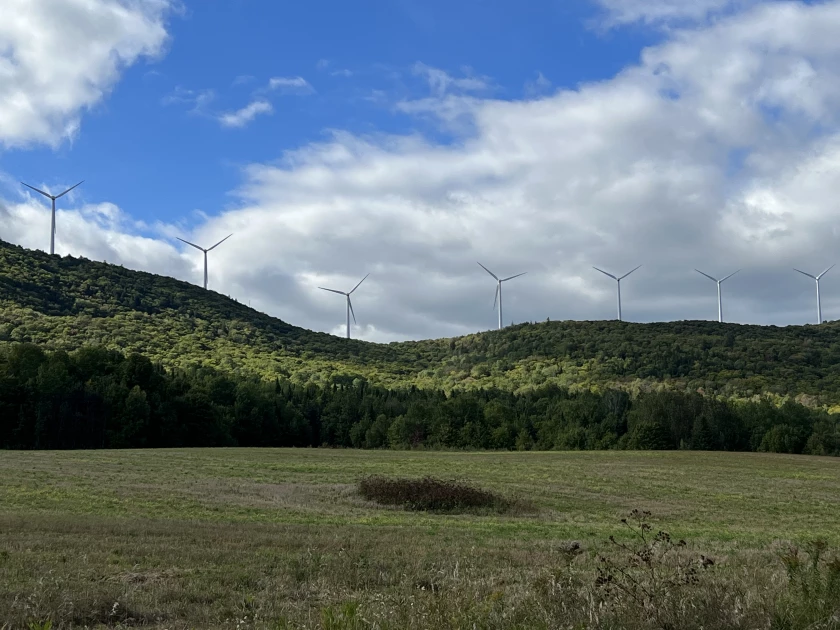Renewable energy corridor to northern Maine clears hurdle with OK from state commission

Seven of the 28 turbines that make up the Mars Hill Wind facility are viewed across a field from a road near the Maine-Canada border. (Kevin Miller/Maine Public)
A major renewable energy project in Aroostook County got a boost Tuesday, as Maine’s Public Utilities Commission concluded that it’s in the public interest. The wind farm and transmission line are driven by Maine’s climate goals.
Longroad Energy’s $2 billion, 1,000-megawatt King Pine wind power project would be New England’s largest onshore wind farm. And the new transmission line by LS Power, would deliver the electricity to the southern Maine grid.
The projects gained support in December, when the Massachusetts Department of Energy Resources agreed to contract for up to 40% of the power, and 40% of the transmission line payments. Maine ratepayers are on the hook for the remainder.
“The cost to Maine ratepayers for a 60% share of these projects, would be approximately $1 billion,” said PUC Chair Phil Barlett. “To put this into context, the average Maine residential ratepayer would pay about $1 per month for the first 10 years of these contracts.”
He said the costs are in line with the goals of the renewable energy legislation that opened the door for the project.
“While the cost of these projects is significant, they are in the range that policy makers should reasonably have expected in passing the legislation,” Bartlett says.
Commissioner Patrick Scully agreed that the project is clearly in the public interest, and advances the state’s climate goals, but expressed concerns over the funding mechanism for this and other renewable energy projects.
“And by choosing to fund these programs through electricity rates, which are by nature regressive, we impose a tremendous burden on our many low and moderate income and fixed income residents,” Scully said.
But Jack Shapiro, of the Natural Resources Council of Maine, said the way to save ratepayers money is to shift toward renewable energy, and away from fossil fuels.
“Costs are very important. But as people are struggling with energy costs right now, what’s causing those energy costs is high fossil fuel prices, and that’s what we have to bring to an end,” Shapiro said.
And he said the Aroostook project is a big step in that direction.
“It’s a great example of the kind of collaboration we’re going to need to bring the renewable energy that we’ll need to address climate change online, as well as to get us off of our dependence on fossil fuels,” he said.
Senate President Troy Jackson of Allagash, who sponsored the legislation that enabled the project, said it will unleash the economic potential of Aroostook County. But he said he’s also focused on the potential savings for ratepayers.
“For me it’s more about what does it do for senior citizens, low-income people, this is a real shot in the arm for people that are experiencing high costs right now, based, unfortunately, on natural gas prices,” Jackson said.
If they pass all of the regulatory hurdles, the projects could deliver energy to the grid by 2028.
